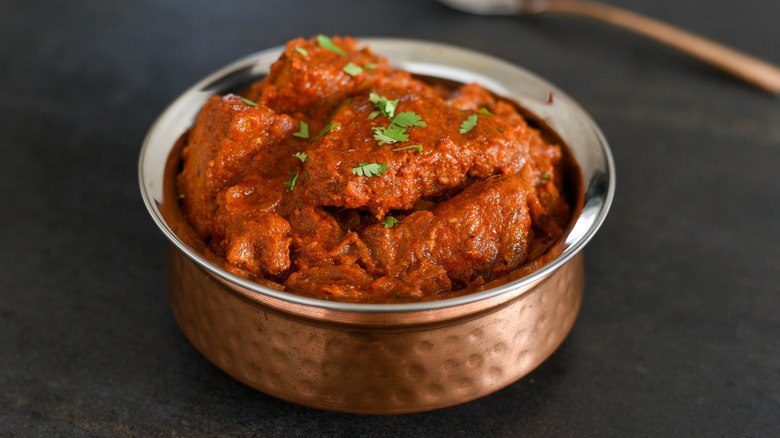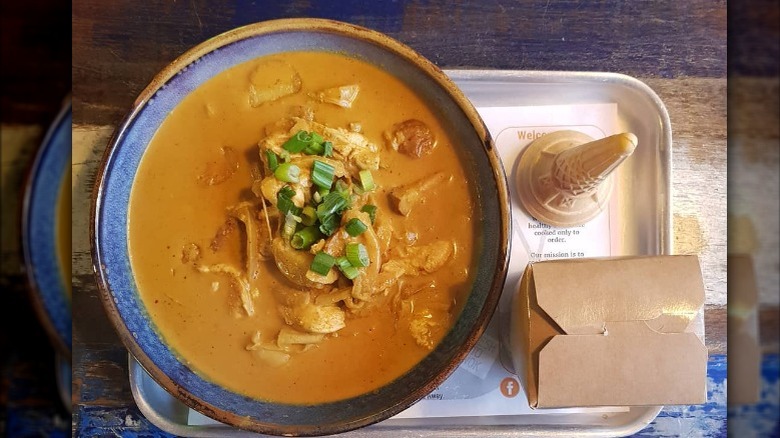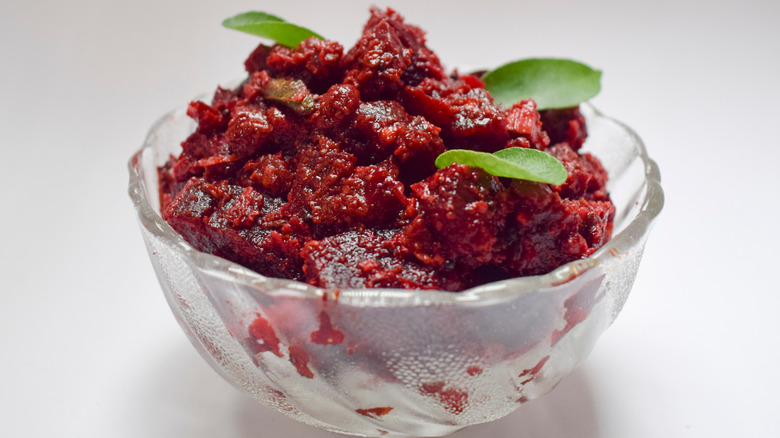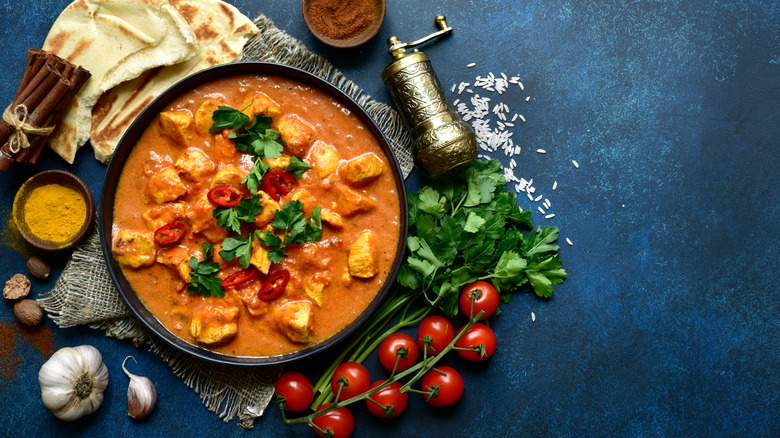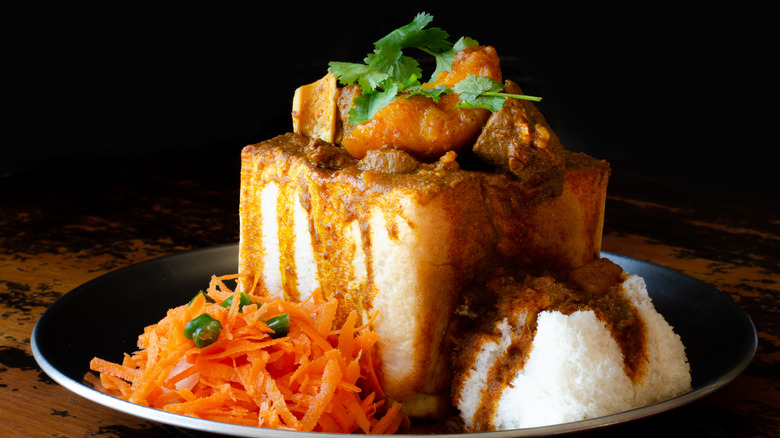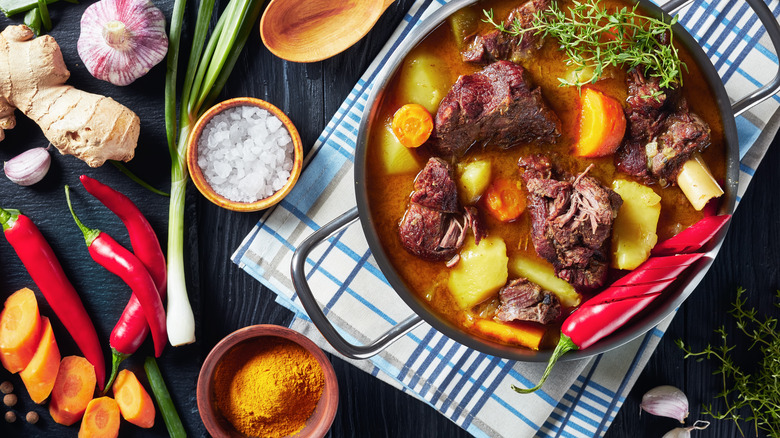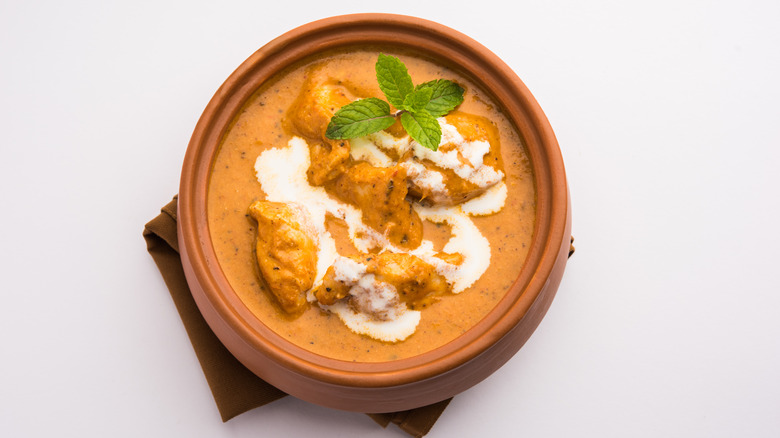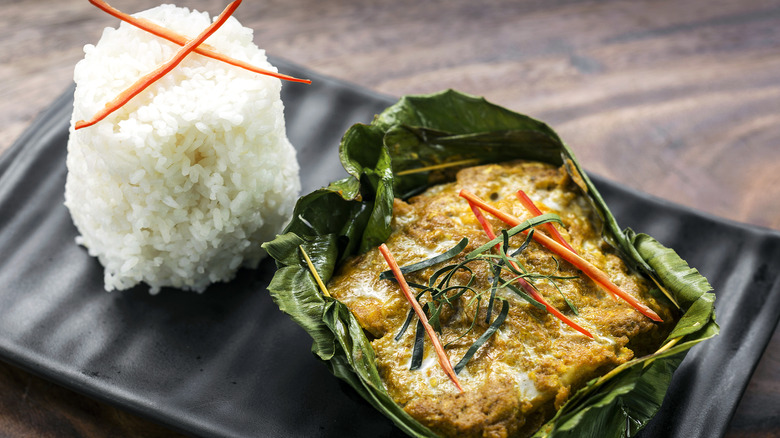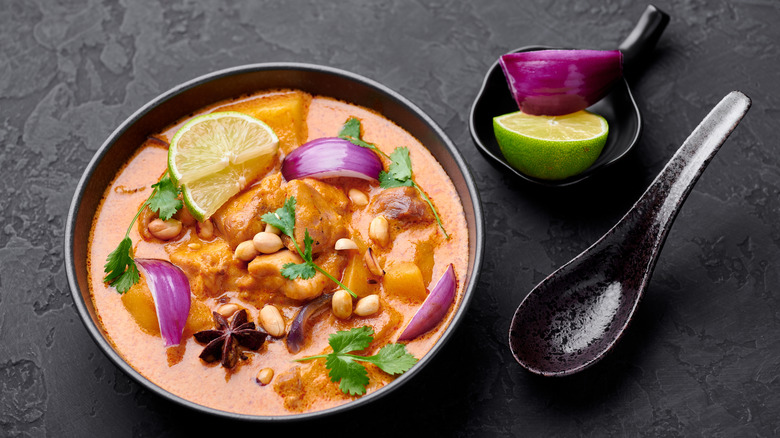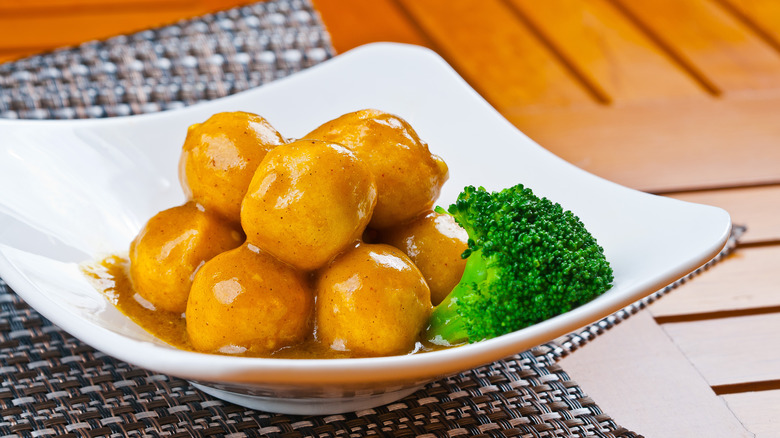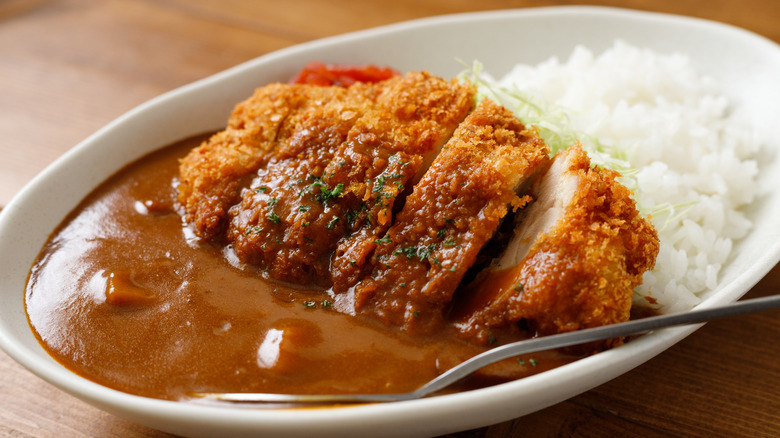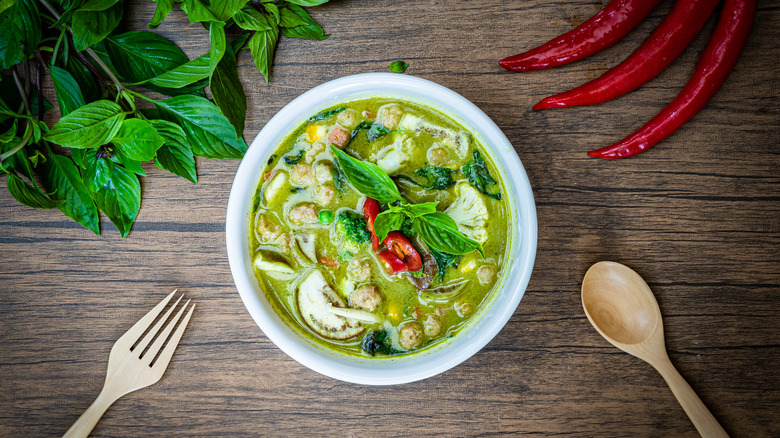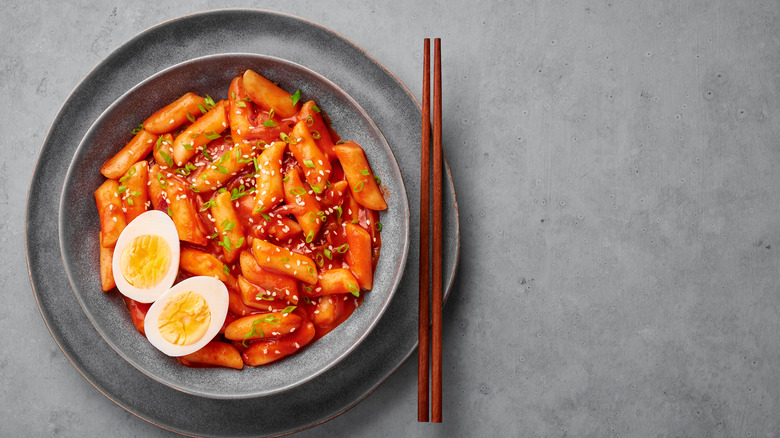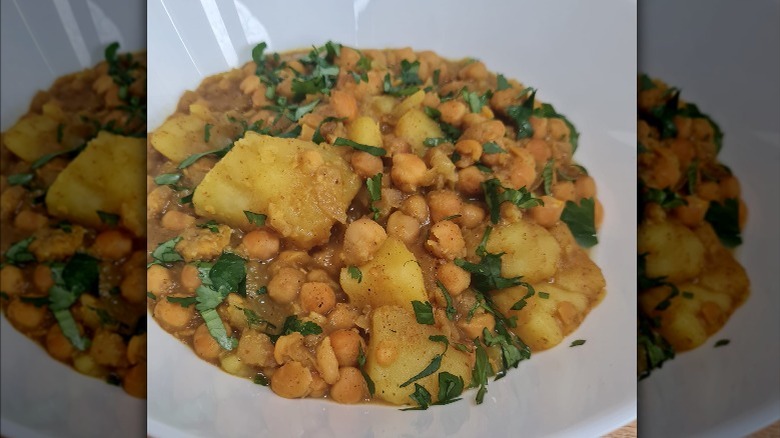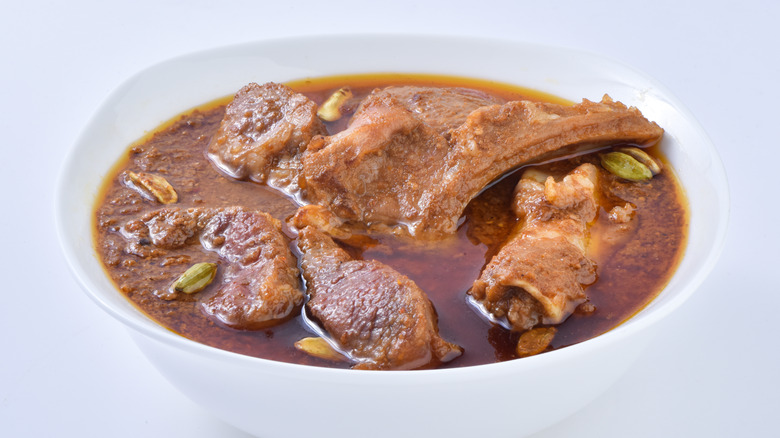14 Types Of Curry From Around The World
No matter what corner of the world you find yourself in, there's bound to be a curry dish nearby that will hit those flavor notes with a heady combination of sweet, spicy, sour, and salty. Although Indian cuisine is famous for its dazzling array of curries and inventive use of different spices and flavor profiles (via Daily Mail), other countries from Trinidad to Japan have their own spin on and interpretations of curry that will give you a new appreciation for the cuisine.
With tons of international dining options available in most major U.S. cities (via Business Insider), there's no reason not to grab yourself a big spoonful of tasty tteokbokki (and yes, that's with two t's) or a warming bowl of Massaman curry. No matter your taste or spice preference, there's a beautifully-blended curry waiting for you to devour. These 14 curries represent the best of the best, with both creative and classic renditions of mouthwatering curry.
Rendang Curry
Rendang curry might not have the name recognition of red curry or Massaman curry. Still, it's arguably one of the most mouthwatering dishes on the planet and a top Indonesian food you should try. From the profoundly flavorful, tender meat to the silky notes of coconut and rich accents of chili and spice, Rendang curry is anything but one note and refers to a way of preparing food rather than a specific type of curry (via Wonderful Indonesia).
According to Science Direct, tenderloin is the cut of choice for the perfect Rendang curry, playing nicely with the copious amount of fresh coconut milk that makes up the bulk of the dish. In addition to its intense and addictive flavor profile, Rendang curry keeps for a good long time, thanks to a complex blend of spices and aromatics (via Wonderful Indonesia). It also has a long history in West Sumatra and was originally a prized food of Indonesia's native Minang population.
Beetroot Curry
This hearty vegetarian curry from Sri Lanka combines luscious, deep-purple beets with curry, spice, ginger, and onions for a complex but not overpowering dish guaranteed to give you your daily dose of five vegetables. The Montreal Gazette says beetroot curry hits all the right sweet, salty, and sour notes. The combination of sugary beets, tart tomatoes, decadent coconut, and hot spices is definitely a feast for your palate — and you won't even miss the meat. Plus, it's a balanced dish where no one flavor overpowers any other.
According to Business Destinations, Sri Lanka is one of the top countries in the world to savor a tasty vegetarian meal, and this beetroot curry is a prime example of its inventive vegetarian and vegan cooking. So pair your beetroot curry with a generous scoop of wild rice and a sprinkle of coriander and lemon, and prepare for a great guilt-free indulgence.
Chicken Tikka Masala
Chicken Tikka Masala, not to be confused with Chicken Tikka, is an extraordinarily popular British dish, celebrated on London's legendary "Curry Mile" (via South China Morning Post) and possibly one of the first fusion cuisine successes (via Encyclopedia Britannica). This curry has a winning combination of ingredients; juicy boneless chicken, a cream-based sauce, and a mild blend of spices that will hit the spot at 3 a.m. but not leave you with heartburn.
According to Encyclopedia Britannica, Chicken Tikka Masala's roots are muddled. It might have been the brainchild of a chef from Bangladesh working in Scotland who adapted Chicken Tikka to the Western palate by tossing on a rich tomato cream sauce. It could also be a British take on India's famous butter chicken, one of the most beloved dishes on the planet. If you don't find yourself wandering London's Curry Mile anytime soon, you can always recreate this dish in your kitchen.
Bunny Chow
South Africa's bunny chow wins high marks for creativity and deliciousness, packing a nice rich curry punch into innovative packaging. According to Atlas Obscura, bunny chow comes in a scooped out end of bread, making it portable and totally edible. Not only does the bread serve as a vessel for the curry, but it also soaks up all of those great juices and flavors. Whether you're in the streets of Capetown, Durban, or Johannesburg, you're probably not too far from one of these yummy "bunnies," and you shouldn't pass up the chance to try one.
The curry can be vegetarian, a rich chicken blend, or traditional mutton. You can also order your bunny chow to size, using the loaf as a measurement. Although bunny chow is a cherished South African street food today, it does have grim roots leading back to apartheid, when Black patrons couldn't visit white establishments (via NPR).
Jamaican Goat Curry
Jamaican goat curry is another exceptional example of multi-cultural influences coming together to create one smashing dish (via Jamaica 55). According to The Guardian, Jamaican goat curry is a classic dish featuring either mutton or goat, plus a hit of acidity from the lime, ginger, Scotch bonnet chili peppers, potatoes, and plenty of fresh herbs and spices. The result is a taste that's earthy and meaty with a splash of brightness from the citrus and ginger. In addition, fresh herbs like parsley and coriander add a substantial dose of freshness to the dish and balance out the stronger, richer elements.
Since goat is a gamier kind of meat, this curry has a slightly different flavor than your standard beef, chicken, or vegetarian curries, although the balance of ingredients means that the goat or mutton is never too overwhelming. Serve it over a spoonful of rice for a complex but still familiar dish.
Butter Chicken
According to Fodors, butter chicken is one of the most popular dishes in India and is rapidly gaining traction all over the world thanks to its stellar combination of juicy chicken, creamy buttery sauce, and melt-in-your-mouth rice. Pair your butter chicken with a piping hot round of naan bread or roti, and you're headed straight for carbohydrate heaven. As with many of the top curries on our list — and, let's be honest, top dishes and drinks in general — butter chicken's origins are hotly contested (via Fodors). Fortunately, you don't have to pick team Kundan Lal Gujral or team Kundan Lal Jaggi (two of India's once famous chefs and restaurateurs) to enjoy butter chicken at any number of different Indian restaurants or at home.
Although butter chicken is undeniably decadent, all of this buttery, creamy flavor comes with a serious caloric price. So if you do decide to indulge, remember that the mantra everything in moderation — including and especially butter chicken — is the way to go.
Fish Amok
Even serious foodies often overlook the bounty of Cambodian cuisine, despite its deeply-rooted history and cornucopia of different flavors (via CNN), but you shouldn't make the mistake of giving Cambodian food a miss, especially when it comes to luxe and lovely fish amok. According to Southeast Asia Backpacker, fish amok has roots in the ancient Khmer Empire. It's a rich, creamy dish that mingles a unique blend of Cambodian spices with rich coconut milk, sugar, and fish sauce for a flavorful, sweet, salty, and spicy mix that works well with local Mekong River fish.
What makes fish amok so special is that most curries use beef, vegetables, or chicken as their main proteins, but delicate fish works beautifully in this dish. Additionally, the inspired combination of fish sauce and palm sugar gives fish amok a lovely balance that allows both ingredients to shine without overpowering any part of the dish.
Massaman Curry
Massaman curry is easily one of the tastiest dishes to come out of Thailand, which is saying something considering we're talking about the land of fresh papaya salad and bowls of hot noodle soup. Unlike many Thai curries, Massaman isn't all that spicy (via The Guardian), but that doesn't mean it's any slouch in the flavor department. The perfect Massaman is studded with big chunks of potato, beef, and a liberal sprinkling of peanuts. You also get a lot of warm notes in Massaman curry, like heady cloves and cardamom, which give the dish dimension without extra heat.
At its core, Massaman curry is simply comforting food, and you can certainly customize yours to taste by swapping out the proteins or adding different vegetables. Serve your Massaman curry over a heaping spoonful or two of hot rice, and you have a huge bowl of savory and sweet goodness that invokes Thailand's flavors.
Curry Fish Balls
Hong Kong's iconic fishballs get a serious flavor boost in this decadent and delicious curry dish that is truly one of the pinnacles of Hong Kong street food cuisine. Fishball curry is exactly what it sounds like; dense, tasty fishballs in a vibrant curry sauce full of garlic, chilis, curry, and coconut milk (via The Woks of Life). As with much classic Asian cuisine, these fiery little balls get all of the flavor right, with salty, sweet, spicy, and umami tastes shining through.
What's more, fishball curry is part of Hong Kong's national identity (via South China Morning Post). Hong Kong street vendors were the ones to give fishballs their classic glow-up by tossing them in hot oil and crowning them with warm, golden curry. Fishball curry is genuinely one of the most unique tastes on our list, with the twin wins of being a delicious dish and a point of Hong Kong pride.
Japanese Curry
Japanese curry is much sweeter and thicker than its Indian counterpart, a modified take on British curries rather than fiery and spice-heavy Indian blends. Its origin story is a bit of a mystery. According to Vice, Japanese curry was the product of a happy accident, thanks to a stranded sailor who introduced the tiny island nation to his concept of curry. British curry is much thicker than Indian curry and far sweeter, and it's rapidly become a Japanese comfort-food standard.
The Takeout has a different version. Instead of a shipwreck washing curry onto Japan's shores, it was brought there on purpose when the Meiji Emperor opened up trade. Whether Japanese curry came accidentally or deliberately might be up for debate, but it's indisputable that this curry dish is in a class all its own. Served with vegetables, rice, and breaded meat, it's a beautiful classic dish that you can replicate at home.
Green Curry
It's a common misconception that Thailand's green curry is naturally sweeter than its heat-drenched red curry, but National Geographic points out that both red and green chilis have near-identical heat indexes. The cooling aspects of green curry come from other additives, like silky coconut milk and sugar, both of which balance out the hot green chilis beautifully. Green curry is slightly more palatable to Western taste buds while still hitting all of those traditional Thai notes of spice, sweet, sour, and salt (via Asia Highlights).
Packed with traditional vegetables and served atop a steaming pile of rice, green curry is a masterpiece of tastes, textures, and flavors. Authentic green curry has a bright hit of lemongrass and kaffir lime and spicy garlic, and shallots. Of course, if you're a Westerner who can handle the heat, you can always order yours with extra spice or make green curry at home.
Tteokbokki
If you love five-alarm curry bursting with a symphony of different flavors and textures, get your hands on some tteokbokki. This garlic-heavy, bright and spicy curry has some sweet notes lingering on the end, which give it a sumptuous flavor that balances the heat beautifully. According to Serious Eats, this traditional South Korean fast food staple might just be one of the world's finest spicy foods, and one bite could make you a believer.
Tteokbokki gets its fiery edge from gochugaru chili and gochujang. According to Chili Pepper Madness, gochugaru chili powder is deeply complex, with an underlying sweetness that compliments the spice. While some spicy foods tend to be one-note, tteokbokki is boldly multi-dimensional. While nothing beats a steaming bowl of tteokbokki from a street vendor in Seoul, you can also make this dish from the comfort of your own kitchen — just be careful with the gochugaru as you're playing with fire, literally.
Channa Aloo
According to The New York Times, Trinidad's channa aloo is herb-heavy on a cherished Indian dish. Instead of heavier ingredients like pungent tomatoes and Indian spices, Trinidad's version incorporates plenty of fresh herbs and cilantro, the perfect foil to dense potatoes and chickpeas. As a result, it's far lighter than its Indian cousin and definitely one of the main global curries that you should get into your belly ASAP.
If you want to make channa aloo at home, you should use a fiery habanero chili to taste (via The New York Times). The longer you keep the chili simmering away in your pot of channa aloo, the hotter the end result will be, so use caution if your palate isn't accustomed to spicier flavor notes. Habanero chilis are the perfect complement to neutral russet potatoes and bright cilantro, lending themselves to an ideally balanced plate of totally Trinidadian curry.
Qorma
According to Scroll, qorma is the ruler of all Indian curries, a sumptuous meat, and vegetable dish that takes on different variations and flavor profiles depending on what corner of the Indian subcontinent you find it in. Whether coated in a delicious sauce or served with a flavorful dry rub, qorma is a multi-layered flavor experience that puts many other curries to shame. Scroll points out that there are a few distinct variations on the theme coming from the north of India, Kashmir, and the southern part of India.
Southern qorma takes on tropical flavors with a fiery blend heavy on coconut for a nuanced and balanced flavor. Northern qorma has a cream sauce, nuts, and a dollop of yogurt — and qorma from Kashmir is heavy on the spice with plenty of turmeric and fennel. It rounds things off with a sour hit of tamarind on the back end.
